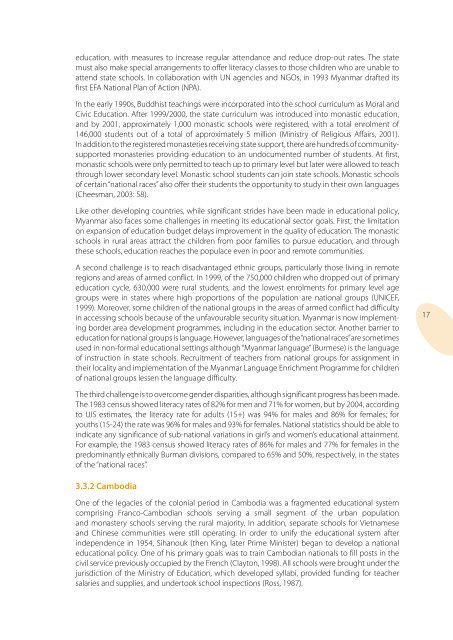Asia and the Pacific Education for All (EFA) mid-decade assessment ...
Asia and the Pacific Education for All (EFA) mid-decade assessment ...
Asia and the Pacific Education for All (EFA) mid-decade assessment ...
You also want an ePaper? Increase the reach of your titles
YUMPU automatically turns print PDFs into web optimized ePapers that Google loves.
education, with measures to increase regular attendance <strong>and</strong> reduce drop-out rates. The state<br />
must also make special arrangements to offer literacy classes to those children who are unable to<br />
attend state schools. In collaboration with UN agencies <strong>and</strong> NGOs, in 1993 Myanmar drafted its<br />
first <strong>EFA</strong> National Plan of Action (NPA).<br />
In <strong>the</strong> early 1990s, Buddhist teachings were incorporated into <strong>the</strong> school curriculum as Moral <strong>and</strong><br />
Civic <strong>Education</strong>. After 1999/2000, <strong>the</strong> state curriculum was introduced into monastic education,<br />
<strong>and</strong> by 2001, approximately 1,000 monastic schools were registered, with a total enrolment of<br />
146,000 students out of a total of approximately 5 million (Ministry of Religious Affairs, 2001).<br />
In addition to <strong>the</strong> registered monasteries receiving state support, <strong>the</strong>re are hundreds of communitysupported<br />
monasteries providing education to an un docu mented number of students. At first,<br />
monastic schools were only permitted to teach up to primary level but later were allowed to teach<br />
through lower secondary level. Monastic school students can join state schools. Monastic schools<br />
of certain “national races” also offer <strong>the</strong>ir students <strong>the</strong> opportunity to study in <strong>the</strong>ir own languages<br />
(Cheesman, 2003: 58).<br />
Like o<strong>the</strong>r developing countries, while significant strides have been made in educational policy,<br />
Myanmar also faces some challenges in meeting its educational sector goals. First, <strong>the</strong> limitation<br />
on expansion of education budget delays improvement in <strong>the</strong> quality of education. The monastic<br />
schools in rural areas attract <strong>the</strong> children from poor families to pursue education, <strong>and</strong> through<br />
<strong>the</strong>se schools, education reaches <strong>the</strong> populace even in poor <strong>and</strong> remote communities.<br />
A second challenge is to reach disadvantaged ethnic groups, particularly those living in remote<br />
regions <strong>and</strong> areas of armed conflict. In 1999, of <strong>the</strong> 750,000 children who dropped out of primary<br />
education cycle, 630,000 were rural students, <strong>and</strong> <strong>the</strong> lowest enrolments <strong>for</strong> primary level age<br />
groups were in states where high proportions of <strong>the</strong> population are national groups (UNICEF,<br />
1999). Moreover, some children of <strong>the</strong> national groups in <strong>the</strong> areas of armed conflict had difficulty<br />
in accessing schools because of <strong>the</strong> unfavourable security situation. Myanmar is now implementing<br />
border area development programmes, including in <strong>the</strong> educa tion sector. Ano<strong>the</strong>r barrier to<br />
education <strong>for</strong> national groups is language. However, languages of <strong>the</strong> “national races” are sometimes<br />
used in non-<strong>for</strong>mal educational settings although “Myanmar language” (Burmese) is <strong>the</strong> language<br />
of instruction in state schools. Recruitment of teachers from national groups <strong>for</strong> assignment in<br />
<strong>the</strong>ir locality <strong>and</strong> implementation of <strong>the</strong> Myanmar Language Enrichment Programme <strong>for</strong> children<br />
of national groups lessen <strong>the</strong> language difficulty.<br />
17<br />
The third challenge is to overcome gender disparities, although significant pro gress has been made.<br />
The 1983 census showed literacy rates of 82% <strong>for</strong> men <strong>and</strong> 71% <strong>for</strong> women, but by 2004, according<br />
to UIS estimates, <strong>the</strong> literacy rate <strong>for</strong> adults (15+) was 94% <strong>for</strong> males <strong>and</strong> 86% <strong>for</strong> females; <strong>for</strong><br />
youths (15-24) <strong>the</strong> rate was 96% <strong>for</strong> males <strong>and</strong> 93% <strong>for</strong> females. National statistics should be able to<br />
indicate any significance of sub-national variations in girl’s <strong>and</strong> women’s educational attainment.<br />
For example, <strong>the</strong> 1983 census showed literacy rates of 86% <strong>for</strong> males <strong>and</strong> 77% <strong>for</strong> females in <strong>the</strong><br />
predominantly ethnically Burman divisions, compared to 65% <strong>and</strong> 50%, respectively, in <strong>the</strong> states<br />
of <strong>the</strong> “national races”.<br />
3.3.2 Cambodia<br />
One of <strong>the</strong> legacies of <strong>the</strong> colonial period in Cambodia was a fragmented educational system<br />
comprising Franco-Cambodian schools serving a small segment of <strong>the</strong> urban popu la tion<br />
<strong>and</strong> monastery schools serving <strong>the</strong> rural majority. In addition, separate schools <strong>for</strong> Vietnamese<br />
<strong>and</strong> Chinese communities were still operating. In order to unify <strong>the</strong> educational system after<br />
independence in 1954, Sihanouk (<strong>the</strong>n King, later Prime Minister) began to develop a national<br />
educational policy. One of his primary goals was to train Cambodian nationals to fill posts in <strong>the</strong><br />
civil service previously occupied by <strong>the</strong> French (Clayton, 1998). <strong>All</strong> schools were brought under <strong>the</strong><br />
jurisdiction of <strong>the</strong> Ministry of <strong>Education</strong>, which developed syllabi, provided funding <strong>for</strong> teacher<br />
salaries <strong>and</strong> supplies, <strong>and</strong> undertook school inspections (Ross, 1987).

















